Where to go in Switzerland on a short trip: Alps, lakes, and cities
Switzerland is an extremely popular country for those planning multi-stop tours around Europe, yet very few potential first-time visitors actually know specifically where they want to go. Everyone seems to know that it has the most beautiful views of the Alps and some very impressive cities, but there are actually many misconceptions among casual trip planners, so I’d like to clear most of that up below. The places to visit in Switzerland are not obvious until you’ve been there yourself or done many hours of research, so the list below should be a short cut.
I get hundreds if not thousands of itinerary questions for people who are considering a Eurail trip around Europe, and most people just include the word “Switzerland” among a list of cities like Paris, Rome, and Berlin that they want to visit. So where in Switzerland should you go if you can only make a few stops at most? I’ll answer that question below. You’ll mostly want to focus on the best choices for Swiss Alps trips, which I’ll go over below.
Note: This article was expanded and updated in February, 2024.
Switzerland is about outdoor views rather than city visits
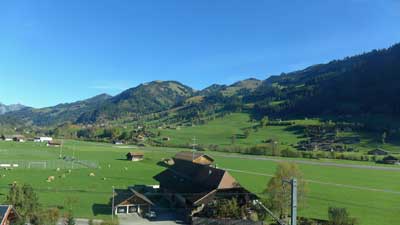
Geneva is a very famous city (though not for tourism reasons) on a lovely lake of the same name, but it’s also notoriously dull and lacking distinction. Rick Steves puts it well by saying that “Geneva is pleasantly situated on a lake, like Buffalo or Cleveland.” The point is, you don’t want to go to Geneva unless you’ve got something specific in mind that you want to see there. There are much better places to visit in Switzerland if your time is limited, or even if it’s not.
Switzerland's cities in summary
Zurich – The largest city, very expensive, geared towards business travelers. It’s generally a pretty and very well-run city that you would enjoy if you visited, but it’s not nearly as interesting as the likes of Vienna, Munich, or of course Paris.
Geneva – Second largest city, in the French part of the country, no major sights. Again, if you visited you’d be very impressed by it and get some great photos, but it’s not worth your time unless you know someone there. There’s an impressive fountain in the lake and you can usually see it from the train as you go through the city, but it’s not really worth going there and staying more than an hour or so.
Basel – Bordering France and Germany, no major sights. It has the famous art market each year, and aside from that it’s even duller than the ones above. Again, if you visited you’d be impressed, but if you later compared photos with friends who went to the Lauterbrunnen Valley instead, you’d kick yourself for going to Basel.
Lausanne – Near Geneva in the French part of the country, very hilly, and certainly more interesting than Geneva.
Bern – The capital, compact, on a lovely river, some interesting sights and the best Swiss city to get a feel for the culture. Bern is fairly close to Interlaken (which we will discuss below) and it can be a great day trip from there, especially on a day where it is foggy and/or rainy in the mountains (and this happens a LOT).
How much time and which Swiss cities to visit?
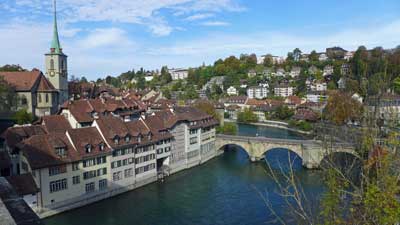
Many people (me included) don’t feel as if they’ve scratched the surface of a new country if they haven’t spent at least a day or two in the largest city. Zurich is certainly pleasant and a useful transit hub so spending one or two nights there wouldn’t be a major mistake. But Zurich isn’t even close to being a city like Paris, Rome, Berlin, Amsterdam, or even Vienna. If you skip it in favor of spending more time in the Swiss Alps, you won’t be missing much.
The 2 Best places to visit in Switzerland for short visits
Interlaken – If you want the best possible Alpine views and activities, head to the Interlaken area, which will be described in detail below. This is my favorite of all places to visit in Switzerland and it will probably be yours as well.
Lucerne – The traditional Swiss tourist retreat, Lucerne is a small city with interesting culture and sights, that is gorgeously set on a lake with plenty of top activities surrounding it.
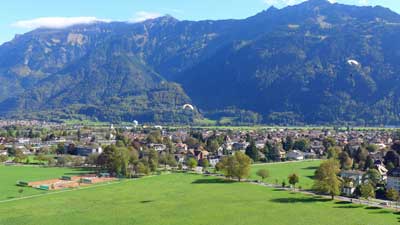
>>>Interlaken and Lucerne: Which to choose and how long to stay in each?
The article linked above will give you more details on which to choose and how long to spend in each place.
What about Zermatt for Alpine views?
Zermatt is a remote car-free village in southern Switzerland that is famous for being the place to see the Matterhorn mountain. It’s also a busy ski resort area, and aside from that, there isn’t much to see or do here. It’s on a private rail line, so it’s more complicated and usually more expensive to reach than Interlaken.
In other words, unless you’ve irrationally placed “Seeing the Matterhorn in person” on your so-called bucket list, skip Zermatt and head to Interlaken on a shorter visit. You won’t be sorry. If you already have enough time in your visit for the main sights around Interlaken and Lucerne and you want to also see the Matterhorn, then by all means go and you’ll enjoy it. There are quite a few other car-free villages in the Lauterbrunnen Valley near Interlaken, so they are not as novel in Switzerland as one might expect.
A weekend in Switzerland? What to see in 3 days
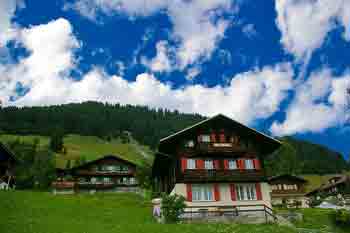
One challenge is that neither has an international airport so you’ll either be flying into Zurich or perhaps Geneva.
Train times from Zurich to Lucerne to Interlaken and back
- Zurich Airport to Lucerne: 1 hour 10 minutes by train
- Lucerne to Interlaken: 2 hours by train
- Interlaken to Zurich Airport: 2 hours 15 minutes by train
As you can see with the travel times above, Zurich Airport to Lucerne is a fairly short trip, but once you add Interlaken into the mix (even if you skip Lucerne) the travel time starts to add up for a weekend visit. With this in mind it’s probably best to just choose one of them and save the other one for another trip.
Lucerne is gorgeous, but the Lauterbrunnen Valley near Interlaken is really the star of the show, so I’d recommend going there first and doing Lucerne on another trip.
What about the Swiss Travel Pass?

The bottom line is that if you are coming to Switzerland for at least 3 days and you want to take 2 or more of the amazing scenic rail journeys that the country is famous for, the travel pass is probably a good deal. It also provides 50% discounts on the Schilthorn cable car and 25% off the Jungfraujoch mountain railway. Both of those are quite expensive on their own, but extremely worthwhile, so the discount is helpful.
The Half Fare Card is probably a better deal for most people
The Swiss Travel Pass is a good deal for those who are going to be spending at least 2 or 3 days riding the rails and seeing Switzerland that way. But if you are mostly going to be focusing on Interlaken and Lucerne and the mountain sights, the Half Fare Card is the best option. For CHF120 (about US$134) you get the card that is good for 30 days and gives you a 50% discount on all trains, cable cars, mountain railways, and other sights and attractions. If you are doing either Schilthorn or Jungfraujoch, the Half Fare Card practically pays for itself with just one of those.
>>>Buy the Swiss Half Fare Card
Many people have questions about the Swiss Half Fare Card so I will explain it a bit here. You can actually buy half price train tickets for travel within Switzerland any time you want and you will see that option when you go to buy them online. The only thing is you have to have and present a valid Half Fare Card when you get on the train and are asked to see your ticket. In other words, you can buy a half fare train ticket today and buy a Half Fare Card just before you get on that train months in the future, and you are fine.
How and why visit the area around Interlaken
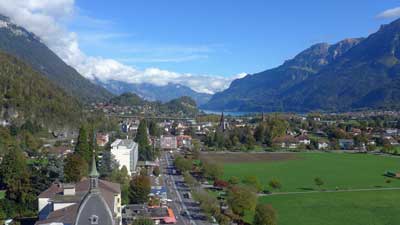
You can see everything discussed below by actually staying in a hotel in Interlaken, but it’s not the Alpine experience that you get if you stay in one of the small villages nearby. You can reach those villages in 20 to 40 minutes from the Interlaken Ost (East) train station, and it’s much easier than it sounds.
The 3 best places to stay to visit the Swiss Alps
Lauterbrunnen – A private train line runs from Interlaken Ost station to the end of its line in Lauterbrunnen. There’s a lovely waterfall here and great hiking trails, but you should probably only stay here if you can’t get to one of the villages mentioned just below. It’s a great little transit hub and it’s definitely gorgeous, so it can be worth a night if you’ve got one to spare.
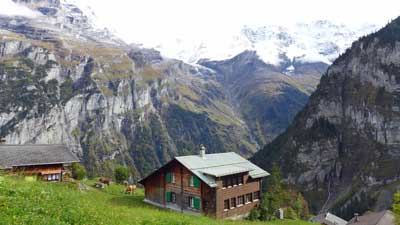
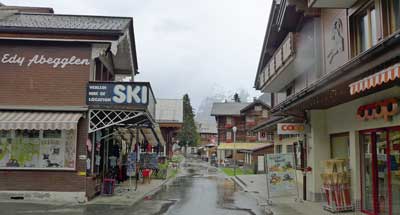
Where to stay in Interlaken and the Lauterbrunnen Valley (with pics)
I get so many questions about where to stay in the Interlaken area that I decided to write a longer version of it and load it with huge photos so readers can get a better feel for each option. I also included recommendations for affordable and well-located photos in each area.
>>>Where to stay in Interlaken and the Lauterbrunnen Valley New for 2024!
The unforgettable things to see here (if the weather is decent)
Schilthorn observation deck and restaurant
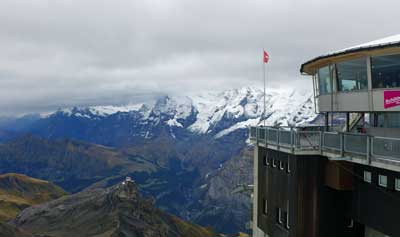
There is a rotating restaurant (with prices similar to normal Swiss restaurants) and a bizarre and anachronistic James Bond attraction based on it being a key location in the 1969 movie On Her Majesty’s Secret Service. The Bond thing is included with the lift, and it’s worth a look.
But the main thing you come here for is the 360-degree view from one of the highest peaks in Europe. Again, the weather here is key, but fortunately all the locals track the visibility on a minute-by-minute basis. If it’s clear up top while you are in the area, it would be a terrible shame to skip it based on the high price. But even if it’s cloudy up top, there are still plenty of wonderful things to see and do in the villages below.
Jungfraujoch observation area
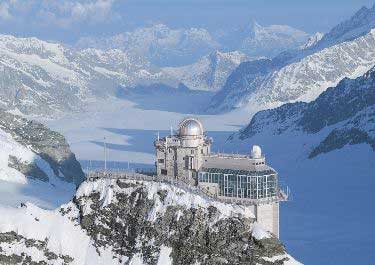
The views from the top are similar to the views from Schilthorn, from the other side of the Lauterbrunnen Valley. Once on top you can have lunch, hike, or even go sledding. It’s also quite expensive at nearly US$200 round-trip unless you have a Swiss Pass or a Eurail Pass for discounts, and it takes most of your day, but you’ll never forget the views from the top.
Harder Kulm mountain and Two Lakes Bridge Observation Deck
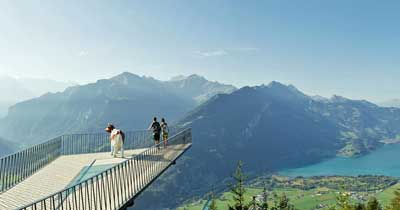
There’s a revolving restaurant about 10 minutes’ walk from the station at the top, which is definitely an unforgettable place for lunch if you’ve got time. It’s not as expensive as you might expect, at least compared to normal restaurants in Switzerland.
The Harder Kulm Railway goes from early April through late November each year. If you are only in Interlaken for one day and/or you are on a strict budget, this is the fastest and best way to get amazing Alpine views in the area.
Getting from Interlaken to Gimmelwald and Mürren
Getting up to these villages sounds complicated and time consuming, but it’s actually fast and easy once you get there. This little guide should help.
Arrive in Interlaken
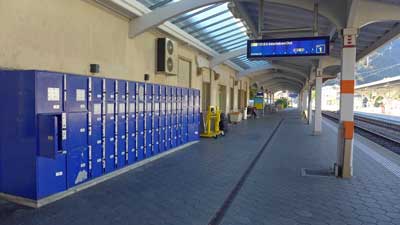
Once you arrive at the Interlaken Ost train station, head for the ticket windows in the office and buy a ticket to your final destination (Lauterbrunnen, Gimmelwald, or Mürren). Eurail passes are good for 25% discounts on the rest of the trip, but not for the whole thing.
From Interlaken Ost to Lauterbrunnen
The private train leaves Interlaken Ost every 30 minutes and arrives in Lauterbrunnen 20 minutes later. If you are staying in Lauterbrunnen then you are probably walking distance from your hotel when you reach the station.
From Lauterbrunnen to Gimmelwald
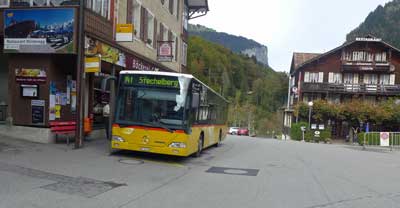

From
Gimmelwald to Mürren
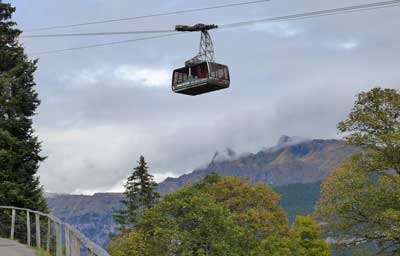
Recommended hotel and hostel in Gimmelwald
I get asked all the time about where to stay in Gimmelwald, so here it is:
Hotel: Esther’s Guesthouse
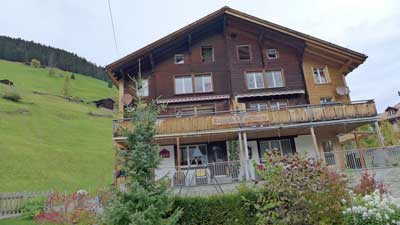
It’s run by Esther, as you might guess, and she is very friendly speaking excellent English. Each room is different and the place feels like a mountain cabin, because it is. She offers an excellent buffet breakfast in the morning, which you have to order the night before. It’s not cheap, but it’s worth it because it’s hearty and there are no other good options nearby.
Book as early as possible because this place is often the first place to sell out in Gimmelwald.
Hostel: Mountain Hostel Gimmelwald
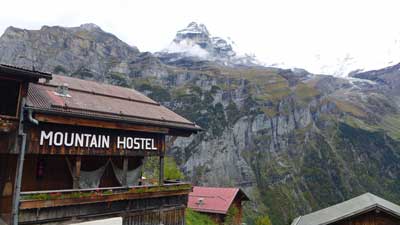
You won’t believe the views from this place, which are the same as from Esther’s except a bit lower and more unobstructed. This place also has a busy bar and restaurant that is basically the only “nightlife” in Gimmelwald. Many hikers get to bed early in this tiny village, but if you want to have a couple drinks and order a pizza or some local options, this is the place to go.
Again, book early because this place is always sold out.
Lucerne and what to do there
Luzern, as it’s spelled locally, is the other traditional holiday destination in Switzerland. Unlike Interlaken, Lucerne actually qualifies as a small city rather than a small resort town, so it’s a very nice contrast and very worthwhile. We have a new article with advice on where to stay in Lucerne and it should be helpful.
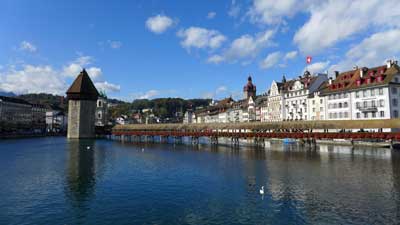
However, unlike Interlaken, the town of Lucerne itself is a great attraction and worth at least a day of exploration. This has always been a rich area so you can expect to find all of the high-end shops and boutiques along the small streets just north of the lake, but there are also many traditional shops and things to see that will appeal to anyone.
Recommended hotel in Lucerne
>>Hotel Des Alpes (3 stars with an amazing location and view)

If this place is booked, which is often the case, then book a hotel as close to it as you can find or afford. The whole historic part of town surrounding it is lovely, with restaurants, bars, and high-end shops. There are also a couple of nearby supermarkets where you can buy inexpensive alcohol and picnic supplies to keep other costs down.
Spend a day in Lucerne itself
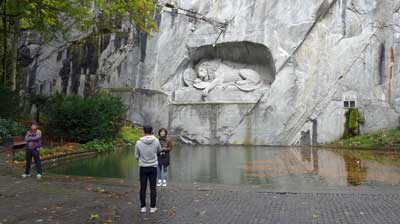
Most of the interesting part of Lucerne is in the area behind those restaurants, and it’s certainly worth doing a self-guided walking tour if not a guided one. Heading farther east you’ll come to another older part of town where the famous lion statue is located. You can’t visit Lucerne without having a look at the lion, and fortunately it’s easy and quick to reach (and it’s free).
Take a lake cruise of some kind
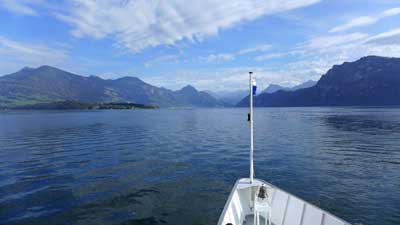
Especially in nice weather, even the short lake tour is lovely, and if you have more time you can jump off at Vitznau and do the scenic hike up Mount Rigi. There are also small lakeside villages that are ideal for a stroll and lunch stop. Long story short, there are dozens of interesting sightseeing options that are available using part of the boat tour, and the views all around are wonderful.
Visit Mount Pilatus
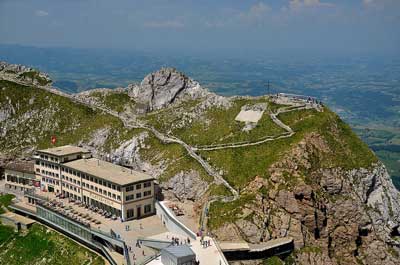
You can take the cogwheel train up and have a more or less flat hike around the summit area, and then take the gondola and cable car back down again. You can do them in the other order, and the cost is the same either way. At around US$65, this is not a cheap hike, but like most everything in Switzerland, the quality is high so it doesn’t feel like a rip-off. You can reach the cable car in 10 minutes on a public trolly bus from Lucerne.
Visit Mount Rigi
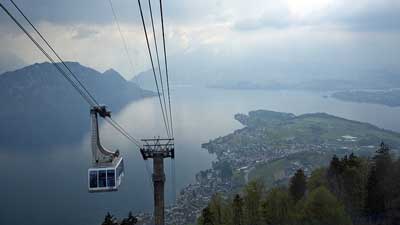
Unlike the other peaks mentioned in this article the Swiss Travel Pass covers both ways to get up and down for free. The others are 50% off with the Swiss Travel Pass or Half Fare Card, except for Jungfraujoch, which is only 25% off with the Swiss Travel Pass and still 50% off with the Half Fare Card.
Visit Mount Titlis
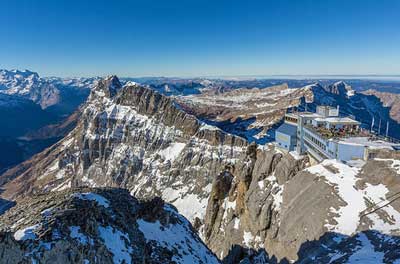
You can reach Titlis by taking a 43-minute train ride from Lucerne to Engelburg and then taking the cable car up from there. As with the others, it’s wise to check the weather immediately before you are going to depart because it can be foggy or cloudy any time of the year, but usually not for whole days at a time.
Additional photo credits
Jungfraujoch by cupweuro on Flickr, Pilatus by Tony Fernandez on Flickr, Rigi by Kosala Bandara on Flickr, Titlis by PaulSchliebs on Flickr

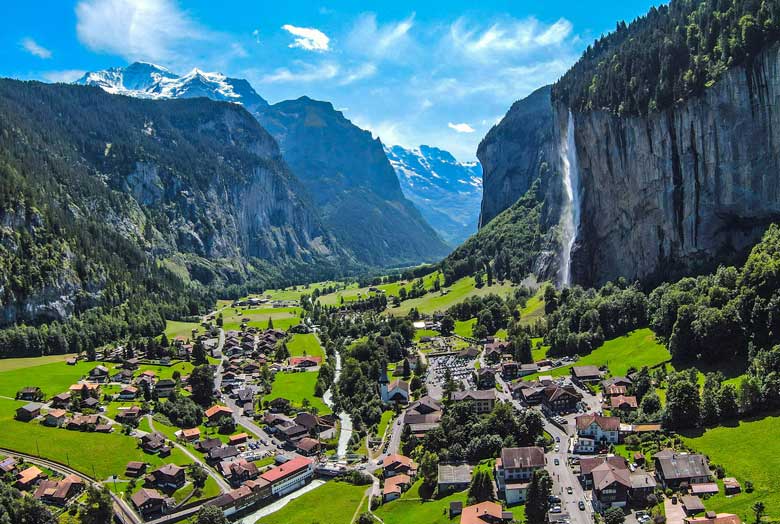
Roger, I lied. I do have another question, given our first night will be in Interlaken…
We will be 90 miles from Lyon and the train to Interlaken would go by Geneva and the lakes and take 5 1/2 hours. Alternatively, we could leave from Dijon which is only 30 miles from where we are staying in France, and the train ride would only be 3:45 but it would go through Bern and bypass Geneva.
Thoughts??
Ted,
This is a tough call. Honestly, all of Switzerland is really lovely out the window of a train, and that even includes the Bern area. But the view of Lake Geneva while going from Geneva to Lausanne and then is especially nice. If they were both the same price I would probably go for the shorter one because that extra hour and 45 minutes will cut into your sightseeing or relaxing once you get there. And again, the train from Dijon to Bern is loaded with fantastic scenery, and at least some of it should be on a lake as well. You will enjoy either one quite a bit. -Roger
Roger, you are the best!
That certainly gives us a much better framework, and I will no doubt have more questions for you as we get closer.
Thank you again!
Ted
Hi Roger,
We are going to Switzerland in September and was hoping you could give us a recommendation for our itinerary. This is our first visit, and would like to focus on Grimwald/Murren/Lauterbrunnen. We are coming from Lyon on Friday and flying out of Zurich at 9:30 on Tuesday.
We will be leaving Lyon around midday on a Friday and traveling into Switzerland. Here is where we need help….where should we go on our first night? Is it worth it to stop in Geneva and look around, or is our time better spent by getting to Interlaken for Friday night? The next question is whether we should spend the rest of our time around Grimwald/Murren or should we go to Lucerne for the day on Monday? Finally, given our flight time Tuesday morning should we go into Zurich Monday night or stay closer to Lucerne and take the train to the airport?
Thank you so much!
Ted
Ted C,
Geneva has a lovely location on a lake, but you can enjoy that while on the train, and the city itself is fairly boring. So I would go straight to Interlaken on your first day. I’d say two days in the Lauterbrunnen, Gimmelwald, Murren area and up to Schilthorn is plenty, and there are other things to do in Wengen, Grindelwald, and even in Interlaken itself. I would go to Lucerne for the day on Monday and stay there that night. Lucerne is a wonderful town to see for a day, and you’ll probably have time for a 2-hour boat cruise. The boats leave from right across from the train station. And there are plenty of hotels near the train station as well, and most are cheaper than what you’d find in Zurich, plus it’s much nicer. From the Lucerne Train Station to the Zurich Airport Train Station it takes about an hour, and the trains start at around 5am, so you’ll have plenty of time, and you don’t even have to go into Zurich to change for the train to the airport. Let me know if you have any other questions. -Roger
Hi Roger
Thank you once again for your useful insights. I am replying to my post of 5th Feb and your response.
We arrive in Geneva on the 13th ,stay one night in Geneva and head to Lucerne. As of now the plan is to stay 4 nights in Lucerne, then move over onto Saren or Interlaken and Bern . We would like to go to Gimmiwaldi to see the snow in the mountains . Where would you recommend we should base our selves .?Berm or Interlaken . From where we are staying would taking the Glacier express be too long of a journey .
Rajitha,
I would base myself in the Interlaken area. Bern is an interesting city, but the scenery in Switzerland is the reason to visit. Gimmelwald is a tiny village about Interlaken, and Murren is a larger village just about Gimmelwald. Murren has a few ski lifts and so it should be easy to visit the snow there, and hopefully in Gimmelwald as well.
As long as you have an extra day, you could do at least part of the Glacier Express. One wonderful thing about Switzerland is that just about every train ride within the country is a “scenic” ride, except some of the trains in the Zurich area. So you could take a train to Brig or one of the other stops on the Glacier Express and then take it from there, or you could just take a train from Interlaken to Zermatt and enjoy the spectacular scenery from that one. Honestly, especially in winter, the scenery all over Switzerland is stunning, so you don’t really have to go so far out of your way to ride one of the special trains with names. Let me know if you have any other questions. -Roger
Hello Roger,
The post is very helpful. My husband and I will be travelling to Switzerland from Luxembourg in March. Following is the tentative itenerary:
20/3 – Lux to Zurich flight (lands at 11.35am) then train to Lucerne
21/3 – Lucerne to Lauterbrunnen/Gimmelwald/Murren
22/3 – Lauterbrunnen/Gimmelwald/Murren to Zurich
23/3 – Zurich to Lux (early morning flight)
We are non-hikers and would like to get the “Switzerland” feel, i.e., Swiss Alps views and lush greenery scenes. We are also travelling on a budget. We can extend the program by a day max.
Q1. Does the itinerary look too rushed; will we get worn out and not relaxed?
Q2. Lauterbrunnen/Gimmelwald/Murren : which one should we opt for?
Q3. Should we purchase the Half Fare card?
Q4. Apart from the return flight tickets from Lux-Zurich, should we purchase train tickets in advance or on day of travel (as I understand, there is no price difference)
Rajshree,
I’m happy this has helped.
A1: It is a bit rushed, but I still think it will be very enjoyable. The sights in the Interlaken and Lucerne areas are some of the most dramatic in all of Europe if not the world, so even a short visit is better than no visit at all.
A2: I would stay in Gimmelwald if you can find a room there, or Murren. Lauterbrunnen is also lovely, but it’s on the valley floor while the other two are on the side of a mountain, so they have much better views.
A3: Probably yes. It’s a simple calculation in that the Half Fare Card costs CHF120 (US$120) and if you’ll be buying at least CHF240 in train, boat, bus, and cable car tickets, it will save you money. It’s pretty hard to stay under CHF240 per person even on a short visit (because the fares without the card are pretty expensive), so it’s a good deal for almost everyone. Especially if you are doing Schilthorn or Jungfraujoch, the Half Fare Card almost pays for itself with just one of those.
A4: There is no real need to purchase the domestic train tickets in advance. Obviously if you buy them once you get there you’ll have to wait in a ticket queue, but those are usually short and the clerks there should all speak fluent English. You might even be able to buy some with machines. Actually, it’s worth checking the train fares online a few weeks out because once in a while they will have a cheap promotional fare, but in my experience usually those promotional fares are on less popular routes, so it’s rare to find a useful one.
One last thing to mention is that you may not want to stay in Zurich on your last night. I know you have a morning flight, but the Swiss trains start running before 5am each day, and the Zurich Airport is its own stop on the system, so you don’t actually have to go to Zurich and then take a special airport train. Lucerne to Zurich Airport is only an hour, so you might even start in Interlaken and then save Lucerne for your last day or two. As long as you are staying fairly close to the Lucerne Train Station, which is where most of the hotels are anyway, you could go directly to the airport from there. The trains in Switzerland are also famously punctual, so you wouldn’t have to worry about a train being more than a few minutes later. Zurich is a nice enough city, but Lucerne is nicer, and Zurich is much more expensive for hotels. There are a few hotels close to the Zurich Airport that are a bit cheaper, so if your flight leaves before 7am you might want to stay at one of those. Let me know if you have any other questions. -Roger
Thanks a lot Roger. Probably at a later date, i will request for more inputs
Hi Roger, I immensely benefited last year from your inputs on Switzerland. Am just trying to push my luck with ur in depth knowledge of the region. I did Schilthorn and Jungfrau based on your recommendatiosn. This year am planning for Italy, Austria and Czech. Just wanted to take your views on Salzburg in particular. Shud I spend time at Inssbruck and Vienna ? I remember reading your posts that Salzburg is the best place to see the Alps.
Nawal,
I’m happy to hear that my advice for Switzerland worked out well. Fortunately, I’m also quite familiar with those other countries as well. Salzburg has a gorgeous setting with a historic old town at the base of a mountain, and a photogenic fortress looking down on it. It’s very different from any of the mountain villages in Switzerland, and I love Salzburg. They make a big deal about Salzburg being the home of Mozart, and fans of the movie The Sound of Music can take a really fun bus tour to the various filming locations. Actually, those bus tours are really wonderful even if you aren’t familiar with the movie because they take you to many of the most scenic spots in the whole area.
Innsbruck, on the other hand, is mostly just a ski resort town. There is almost nothing to see or do there unless you are going up the lifts, so I would skip it if you don’t plan on spending a day in the snow.
Vienna is a grand and important city with excellent architecture and culture, and it’s very different from the other two. Many people go to Vienna to visit the famous royal palaces and attend an opera or classic music concert or see the famous waltz displays. Personally, I’m a fan of nightlife and Vienna feels very old fashioned in that regard. The city is very quiet at night, even though there are a few pubs and bars here and there.
Prague, on the other hand, is really great for nightlife, and the beer is cheap and excellent. I’m also a big fan of Cesky Krumlov, as you may have seen. Two days there is very worthwhile if you have the time. I hope this helps. Let me know if you have any other questions. -Roger
Thank you Roger!
we have decided to drop milan and venice to save costs and have planned for 9 nights in Switzerland – 4 nights in Interlaken. 2 nights in Lucern , 2 nights (??) , & last night in Zurich. We fly in and out from zurich.
1. Where can we stay the 2 nights(??) in between? or should we extend the nights in other cities?
2. We definitely want to do some sections of the Bernani & Glacier express routes during our stay. Is it feasible to stay at Interlaken and cover the bernani express/glacier express routes ( some sections) and be back the same day to Interlaken.(then we’ll extend the stay in Interlaken itself). OR, should we plan a stay overnight at some of the Bernani/Galcier express route drop. We want to cover St. Moriz / Tirano / Lugano , and Visp/Brig -> Zermatt.
3. Please advise for which of these places would we need to spend a night ( & at what location so as to book the hotel there) to optimally cover the bernani & glacier express routes ?
4. Any optimal route/night stay city recommendations to cover the Glacier express / bernani express routes ?
5. Is it feasible to do “Creux du Van – the Swiss Grand Canyon” in Noiraigue the same day from Interlaken.
6. Is Foxtown worth going? Is it very expensive there?
Thank you Roger!
I appreciate the advice; I worried we were trying to jam too much into the trip as well. Just needed someone else to say it 🙂
Hi Roger!
Thank you for all the great tips and information.
Me and three others are traveling to Switzerland, Italy, and Croatia in early June for just over a week. We are coming from the US and are flexible about when we go to each area.
I was thinking we’d fly into Zurich, stay in Interlaken for two nights and Lucerne for one, then take a train to Venice (a friend is stationed at a base near there) where we’ll spend a day or two then go to Croatia for a few days before flying back (either out of Croatia or Venice).
Any tips on our order, airport selection, and the best train routes would be much appreciated!
Thank you!
Alison,
I’m happy to try to help. If by “just over a week” you mean 8 or 9 days, then this trip will be quite a rush. My top tip would be to save Croatia for a future trip. Croatia has a lot going for it, but one challenge is that to get from Italy to Croatia it means taking a ferry that takes all day, or taking a ferry that goes overnight and also takes about 12 hours. And getting to one of the cities in Italy that have ferry crossings will also take many hours. On a map it looks like it should be fast and easy, but at this point it’s neither of those things. If you wanted to fly from Milan to Split you could do it, but again, I would save Croatia for a future trip.
If you did that you’d be able to stay in Interlaken and/or Lucerne for another day each, which would be ideal. It’s slightly faster to go from Zurich Airport to Lucerne to Interlaken and then to Venice, but there are more trains from Lucerne to Venice (all via Milan), so either order could work. And do that train ride to Milan during the day because it’s a gorgeous journey. Venice for 2 days would be great, especially if you have someone there to visit. I wish it were easier to get to Croatia without flying, and flying is still an option. I’m happy to help with more advice if you need it. -Roger